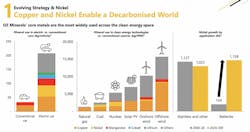Australia nickel mine plans to host world’s largest renewable microgrid
The massive $1.7 billion West Musgrave nickel and copper project — given the green light by Australian mining company Oz Minerals late last week — will be a groundbreaking project for the sheer scale and influence of the renewable energy resources it proposes to harness.
Oz Minerals aims to reach 100% renewable power at the remote mine — located in Western Australia near the borders with South Australia and the Northern Territory — and will start off by providing more than 80% of its power needs from what will be the world’s biggest renewable energy microgrid.
Modeling done so far indicates an optimal mix of around 60 MW of solar and 90 MW of wind, along with a sizable battery — although the specifications of the battery have yet to be finalized.
Oz Minerals believes this configuration will allow the mine and its processing plant to run on “diesel off” or “renewables only” for extended periods.
The size of the battery will likely be decided by the extent to which the company can tailor the operators of the mine and processing plant to when the wind is blowing and the sun is shining, and how much of excess output can afford to be spilled.
See this story for more information on that: Mopping up spilled energy: Mining giant looks to take next step to 100% renewables.
Largest renewable microgrid in world
All this will make it one of the largest operations in the world running on wind and solar only, and its “game changing” operations will be highly informative for the operators of Australia’s national grid which intend to follow the same path over the next decade.
The recognition that wind and solar can play such a significant role even — or perhaps especially — in such a remote location has been one of the decisive factors helping Oz Minerals commit to one of the world’s lowest cost and lowest emission operations.
The cost is important, and so are the emissions, given that Oz Minerals intends to “ride the global electrification wave” and target the surging demand for nickel and copper for electric vehicles, along with the boom in wind, solar and storage in the grid.
The cost of powering such plants with diesel — or gas via a new pipeline — would have been prohibitive. And by focusing on renewables and solar, Oz Minerals has absolute clarity on its electricity costs for the life of the mine.
The West Musgrave transport fleet will initially be powered by fossil fuels, but the company intends to switch to electrify the haul truck fleet at the first opportunity, likely to be the first engine change-out.
It hopes to increase the penetration of renewables to reach net zero scope 1 emissions well before 2038, and expects technology advancements will help it make the leap from 80% to full renewables, most likely in the areas of storage.
Low cost and low emissions
Oz Minerals has actually been looking at the renewables options for West Musgrave for many years – we first wrote about it in 2018 – because it knew then that powering the mine with fossil fuels wasn’t a viable option.
It has long recognized that at such a remote location a big share of renewables was the key to helping it deliver one of the world’s lower cost and lowest emissions copper and nickel mining projects.
The fact that it will supply a low emissions supply of nickel and copper will be important for the electric vehicle markets that it intends to tap into because EV makers also want to ensure their supply chains are low carbon too.
Oz Minerals is currently seeking bids from vendors before finalizing the best mix of wind, solar, battery and diesel, and will then sign a long term power purchase agreement with an option to buy the energy component outright at a later date.
The mine is being built on the land of the Ngaanyatjarra people.
This article originally appeared in







